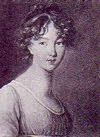
The Brewster Stocking by Jacqueline Fee was featured in the magazine Piecework, January/February, 2010. The pattern for her modern adaptation of the spiral stocking is available by request, from Jacqueline Fee, and is not the sock pattern that appears in the issue of the magazine. It is based on a stocking owned by Pilgrim Hall Museum, Plymouth, Massachusetts and is dated from the 17th century. The article and the photograph of the original stocking stirred up debate on several electronic forums devoted to historical knitting with questions raised as to its dating and previously documented use of the spiral pattern on stockings in the 17th, 18th and 19th centuries. No one, unfortunately, including me, could immediately produce a photograph of or pattern for a spiral stocking although I seem to remember seeing a photograph of such a stocking on a museum website in the past few years. The relative shapelessness of the stocking also gave rise to comments and speculation as to the skills of the original knitter and the owner, believed to have been “William Brewster (1567-1644) of the Plymouth Colony,"* his leg and his health, gout being one of the suggestions due to the width of the leg and shape of the foot.
Since this was an adaptation of a period object, I decided to follow the pattern exactly and not make any changes. The heel flap had been modernized from the traditional long square one of the original stocking but the spiral patterns had been left in the new design much as they had appeared in the original. There is also no seam stitch although there appears to be one in the original stocking, based on the photograph in the article. Ms. Fee has been very helpful since the publication of the article, according to those on the net who have shared their questions and her responses. The pattern was worked from notes and a sketch she did some twenty years ago.
The top of the original stocking also intrigues me. It appears to have two rows of welting that may have been folded over from the inside over to the outside, visible thanks to the part that has rotted or torn or been eaten away. The original stocking had a tension/gauge of 11-13 to the inch and was knit in wool. The size of the needles could only be determined by matching gauge with a similar weight of yarn.
My finished measurements came out a tad different than the pattern suggested ones in spite of swatching. My adapted version is 12 inches in width at the leg, 12 inches around the foot at its widest at the base of the heel, its length measuring 11 inches and the stocking, itself, 10 inches around the garter stitch section near the toe and 25 inches from top to heel. The adapted pattern calls for 2.75mm/2US needles using Bartlett Sport Weight 2 ply-wool to get a tension/gauge of 7 stitches to the inch. In keeping with my oath to stash bust, I swatched with a nameless laceweight, Blackberry Ridge laceweight, Brown Sheep Nature Spun laceweight, and, finally and successfully, Harrisville Design’s New England Shetland (394 yards per skein) in Russet. The stocking used two skeins with just a yard or so left over.
The leg looks wide and unshaped but there is some decreasing. The spiral pattern does not work out evenly round and round the stocking but the difference is minimal and easily adjusted as one knits. I tried to stay true to the pattern (unusual for me) but gave in at the toe which is supposed to be grafted. I simply do not like grafting and do not do it well so I made a drawstring toe.

The spiral pattern does not, unfortunately, really come across that sharply in the photographs. It is easier to appreciate the rippled effect it creates on the sides. Click on the photographs for a larger image.

The stocking was fun to work on, partly because of the spirals and partly because I didn’t have to write the pattern! I decided to make only the one stocking as no one will wear it because of the shape. This modern version was also a dry run in case I want to go back and make a more historically accurate version of the original stocking with more shaping in the leg, a period heel and seam stitch. Knitting with Harrisville Designs Shetland was terrific, too – I adore that wool!
* Fee, Jacqueline. The Brewster Stocking. Piecework, January/February 2010, p. 29


4 comments:
I am in the process of independently publishing an historical novel based on the ill-fated Plockhoy settlement in Colonial Delaware that existed from 1663-1664. The blind protagonist, based on the founder's son, earns his living knitting stockings. I used the 17th century pattern from Plimoth Plantation.The book, Flesh and Grass, is available as an ebook (http://www.amazon.com/Flesh-and-Grass-ebook/dp/B00372644O/ref);
the paperback will be out shortly.
Thanks for the link and the news of your book!
The gout is a reasonable explanation as a bandage could be wrapped around his leg. Another explanation that I have heard of but that I need to find more documentation on is that some upper class men, padded their leg muscles. It is something to look into. I know it's really hard to find period sources for that kind of thing.
I've started a pair, now down past the heel...I did the trad shaping. It is not needed. There is a great amount of stretch in the fabric. Just knit round and round till you decrease for the lower calf/ankle.
It is a tad tricky, but I continued the spirals thru the 'gore' and am now going on the foot.
They look like the original one pictured in Piecework so far. I am almost at the decorative bit at the foot.
Once done, I'll put info + pattern up at whippetsnwool at Wordpress (not yet live)
Ta
Carol Huff
Post a Comment